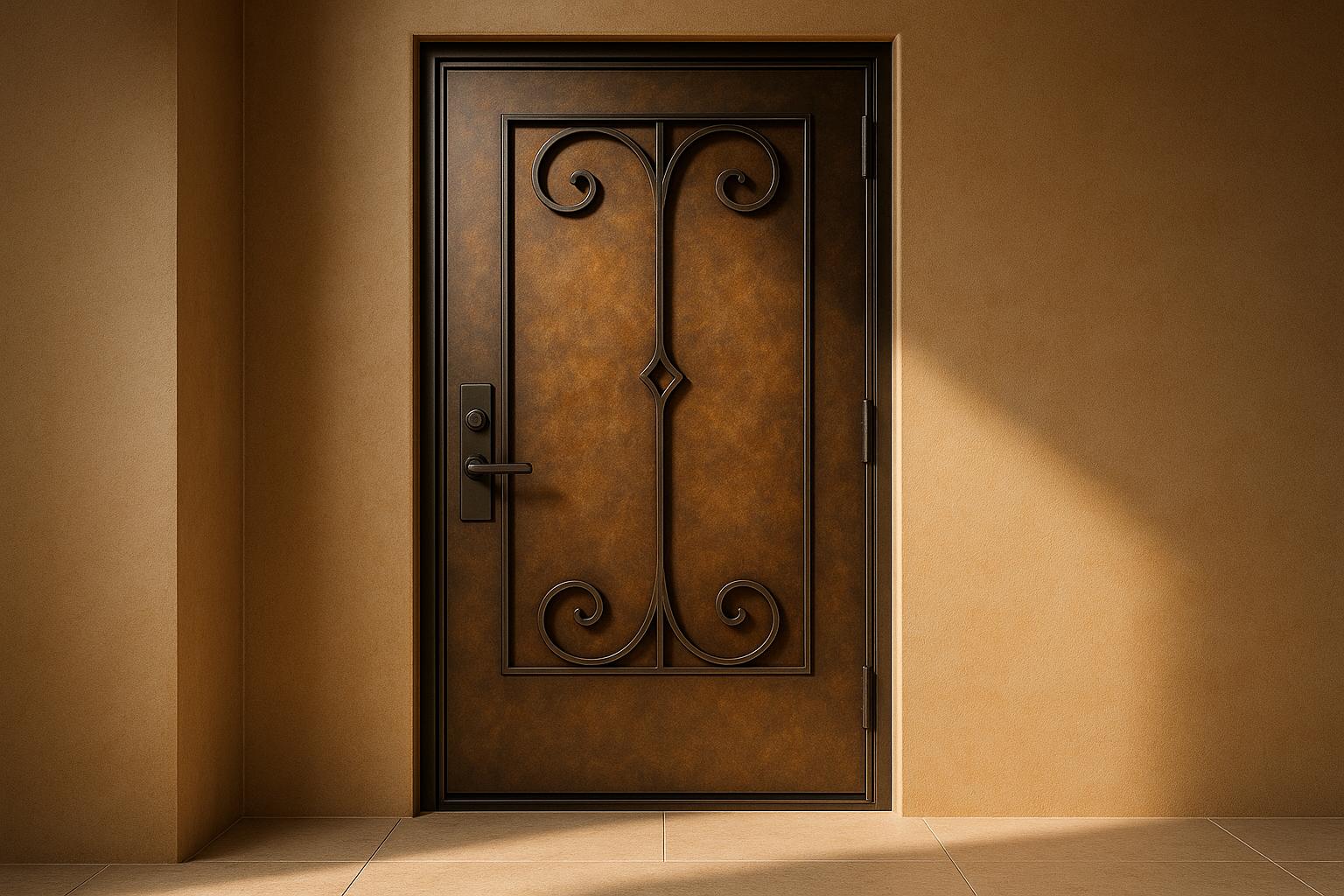Faux painting can elevate wrought iron doors by mimicking materials like bronze or copper, but it comes with challenges. Issues like rust, peeling paint, uneven color, and adhesion problems often arise due to improper preparation, unsuitable products, or environmental factors like humidity. Here’s what you need to know:
- Surface Prep: Remove rust and old paint completely. Clean thoroughly and use a metal-specific primer.
- Adhesion Issues: Use paints designed for metal, like direct-to-metal (DTM) or acrylic latex paints. Allow proper drying time between coats.
- Color Inconsistency: Apply thin, even layers and test finishes on sample boards first.
- Rust Bleed-Through: Eliminate rust and ensure the surface is dry before painting.
- Maintenance: Regularly check for chips, rust, or fading, and reapply protective coatings as needed.
Proper preparation, the right materials, and consistent upkeep are key to achieving a durable, beautiful faux finish on wrought iron doors.
Surface Preparation Problems
Getting the surface ready is a crucial step in faux painting. Skipping or rushing this process often leads to paint issues down the line. A well-prepared surface helps tackle problems like poor adhesion, inconsistent color, and lack of durability.
Leftover Rust and Old Paint
Rust and old paint can seriously interfere with how well the new paint sticks. If rust remains, it can lead to peeling, bubbling, or blistering, ruining the finish. Loose or flaking paint also creates an uneven base. Removing these contaminants is key to achieving a smooth surface. Afterward, take the time to clean thoroughly so the paint has the best chance to adhere properly.
Why Thorough Cleaning Matters
Cleaning the surface isn’t just a suggestion – it’s essential for ensuring the primer sticks well and the finish lasts. Use warm water and a mild detergent with a soft cloth or sponge to clean the area. For tricky spots or detailed areas, a soft-bristled brush works great. Once cleaned, rinse with fresh water and make sure the surface is completely dry to avoid trapping any moisture under the paint.
Using Metal-Specific Primer
Paint Adhesion and Peeling Problems
Even after careful surface prep, issues with paint adhesion can still crop up. Few things are more frustrating than watching paint peel or fail to stick properly, especially on wrought iron doors. These surfaces, with their handles and intricate details, are often touched and prone to wear, making proper adhesion even more critical.
Sometimes, even a well-prepared surface can fall victim to poor product choices or bad timing during application. Factors like extreme temperatures or high humidity can interfere with how well the paint bonds to the surface.
Choosing the Right Paints and Primers
Not all paints and primers are created equal, especially when it comes to metal surfaces. Regular wall paint won’t cut it for wrought iron. You need products that are specifically designed to handle the unique challenges of metal, like its tendency to expand and contract with temperature changes.
A great option is direct-to-metal (DTM) paints, which combine primer and paint into one product. These are formulated to stick directly to metal surfaces, eliminating the need for a separate primer. However, if you’re dealing with older doors or surfaces with peeling paint, using a dedicated metal primer followed by a high-quality metal paint often gives better results.
Acrylic latex paints designed for metal are another solid choice. They’re durable, flexible, and less prone to cracking or peeling compared to oil-based paints, especially in areas with fluctuating temperatures. Always check the label to ensure the product is rated for exterior metal use and offers protection against UV exposure.
Avoid primers meant for wood or drywall – they don’t have the right chemistry to bond with iron. Using them on metal surfaces can lead to peeling and adhesion issues within months.
Proper Drying Times Between Coats
One of the most common mistakes in painting is rushing between coats. While a surface might feel dry to the touch, that doesn’t mean it’s fully cured. Each coat needs enough time to set properly before the next one is applied, or you risk peeling down the line.
Under ideal conditions (70°F to 85°F with low humidity), wait 4 to 6 hours between coats. However, detailed ironwork with recessed designs might need even more time since air circulation is limited in those areas. Trapped moisture or solvents in these spots can delay curing.
Weather plays a big role in drying times. High humidity can significantly slow the process, while painting in direct sunlight can cause the surface to dry too quickly, forming a skin over wet paint underneath. This can lead to peeling later. Always follow the paint manufacturer’s guidelines for recoat windows – the time frame in which you can apply additional coats without needing to sand the surface. If you miss this window, you’ll need to lightly sand before applying the next layer to ensure proper adhesion.
Touch-Up Methods for Chips and Worn Areas
Handles, locks, and other high-contact areas are prone to chipping and wear. Tackling these issues quickly can prevent them from worsening.
Start by cleaning the chipped area with denatured alcohol, then use 220-grit sandpaper to feather the edges, creating a smooth transition between the bare metal and the existing paint. This step helps avoid visible lines where the touch-up meets the original finish.
For small chips, apply a thin coat of metal primer to the exposed iron, then follow up with multiple thin layers of paint rather than a single thick one. Thick paint can peel and create noticeable texture differences.
To make touch-ups blend seamlessly, extend the repair slightly into the surrounding paint. Use a high-quality brush or a small foam roller to match the original texture. If you’re working with a faux finish, you may need to recreate the decorative technique across the entire section to maintain consistency.
Finally, let each touch-up coat cure fully before using the door. Even small areas need 24 to 48 hours to develop the strength needed to withstand regular contact.
Next, we’ll dive into techniques for maintaining consistent color in your faux finish.
Color Inconsistency and Streaking
Uneven color and streaks can take away from the beauty of a faux finish on a wrought iron door. These problems often arise when paint is applied too thickly or without proper testing. Environmental factors, like paint drying too quickly in direct sunlight or too slowly in high humidity, can also play a role in creating an uneven look.
Using the Right Tools for Faux Effects
Applying Thin, Even Layers
To achieve a smooth and consistent finish, it’s best to apply multiple thin layers of paint instead of a single thick one. A good starting point is mixing glaze and paint at a 4:1 ratio. This creates a transparent layer that allows you to build color and depth gradually. If the initial coat looks too bold, you can tweak the mixture to suit your needs.
Testing Color and Finish First
Before working on the actual door, test your faux finish on a sample board to check for consistency. Start by painting a piece of poster board with your base coat and letting it dry completely. Then, apply your faux finish using the same products and ratios you plan to use on the door. This step ensures you’ll achieve the desired effect and helps you spot any issues before committing to the final surface.
When testing, buy small amounts of paint to confirm the color and finish meet your expectations. If your design involves multiple colors, you can adjust the mix by adding more of the lighter color for a brighter effect or more of the darker color for added depth.
Speed up the drying process during testing with a hairdryer. If the finish looks too bold, you can adjust the glaze ratio or lighten the base coat. Keep in mind that digital screens may distort colors, so always check with physical swatches for accuracy. If the glaze dries too quickly while testing, you can extend its drying time by adding a bit of acrylic extender, glycerin, or even a small amount of water. This will give you more time to blend and refine the finish.
sbb-itb-cd90297
Rust Bleed-Through and Moisture Problems
Rust bleed-through and bubbling can ruin the faux finishes on wrought iron doors, especially when the metal’s natural oxidation meets harsh outdoor conditions. Rust forms when iron reacts with oxygen and moisture, a process that speeds up in humid climates like those in North and South Carolina. Factors such as high humidity, frequent rain, and air pollutants make oxidation worse. Rust bleed-through happens when leftover rust seeps through a fresh coat of paint. On the other hand, trapped moisture under the paint can lead to bubbling, which weakens the finish and leaves the iron exposed to more oxidation. Addressing these problems requires meticulous surface preparation and rust removal.
Removing Rust Before Painting
Proper rust removal is key to avoiding these issues. If any rust remains, it will continue spreading beneath the new paint. Start by removing all rust and loose paint from the wrought iron surface using tools like sandpaper, a wire brush, or a wire brush attachment on a cordless drill.
For light surface rust, use fine-grit sandpaper, such as 220 grit, to gently sand the area. For tougher rust, apply a commercial rust remover like naval jelly or a rust converter to stabilize the surface. Once the rust is gone, clean the area with a mild soap solution and water. Rinse thoroughly and ensure the surface is completely dry before moving on.
Making Sure the Surface is Dry
After removing rust, ensuring the surface is fully dry is crucial. Moisture can weaken paint adhesion and promote rust formation. Even tiny amounts of trapped water can cause bubbling and create a breeding ground for rust. Before applying primer or paint, check that the wrought iron door is entirely dry, paying close attention to crevices, joints, and decorative details where moisture often lingers.
Maintaining Faux Painted Wrought Iron Doors
Once you’ve addressed any surface or adhesion problems, keeping up with regular maintenance is key to preserving your faux finish.
Check your wrought iron door every three to six months for signs of wear, like chips, fading, or rust spots. Spotting these issues early can save you from costly repairs or even the need for a full refinishing down the line.
For minor damage, act quickly. Keep leftover paint on hand, clean the affected area, apply a metal-specific primer to any exposed metal, and carefully blend the new paint into the original finish.
It’s also a good idea to reapply protective topcoats every two to three years. If you’re in a humid area, you might need to touch up more often to combat the added moisture.
For more serious problems, such as spreading rust, malfunctioning door mechanisms, or deep scratches, consider hiring a professional. Tasks like sandblasting to remove extensive rust require specialized tools and skills that most homeowners don’t have. Regular professional inspections can complement your routine maintenance and help catch issues before they escalate.
For day-to-day care, you can reach out to Forever Iron Doors Carolina. They offer customized maintenance services designed to protect your door’s appearance and durability, especially when dealing with the challenges of local weather conditions.
Don’t forget seasonal upkeep, too. Clean the door with mild soap, check the hardware and weather seals, and during winter, keep an eye on areas exposed to salt or de-icing chemicals to prevent corrosion.
FAQs
What are the common mistakes to avoid when preparing wrought iron surfaces for faux painting?
One major misstep when working with wrought iron is neglecting proper cleaning and rust removal. Skipping this step can cause the paint to stick poorly, leaving you with an uneven, unattractive finish. Another common error? Not sanding the surface enough. Without adequate sanding, the paint struggles to adhere properly, often leading to a blotchy, inconsistent look.
To sidestep these issues, take the time to thoroughly clean the wrought iron, neutralize any rust, and sand the surface until it’s smooth. Don’t forget to apply a high-quality primer before painting – this step is key to ensuring a long-lasting, polished faux finish.
What can I do to keep my faux painted wrought iron door looking vibrant and lasting longer?
To keep your faux painted wrought iron door looking fresh and lasting longer, regular cleaning is key. Use a soft cloth or sponge with a mild soap and water mix to gently wipe away dirt and grime. Stay away from abrasive cleaners or tools, as they can scratch or damage the finish.
For added protection, consider applying a clear coat or sealant specifically designed for exterior metal surfaces. This extra layer helps defend against fading, rust, and weather-related wear. It’s also a good idea to touch up the faux finish whenever needed and address any rust spots immediately to stop them from spreading. With these simple care tips, your door can maintain its charm and strength for years to come.
How can I fix rust or peeling paint on my faux painted wrought iron door?
To fix rust or peeling paint on your faux-painted wrought iron door, begin by scraping off rust or loose paint with a wire brush or using a chemical paint stripper. Once that’s done, sand the surface to make it smooth and clear away any leftover debris. After preparing the surface, apply a rust-resistant primer to shield the metal and help stop corrosion. Finish by repainting the door with a high-quality metal paint made for outdoor use, giving it a fresh look and long-lasting protection from the weather.



